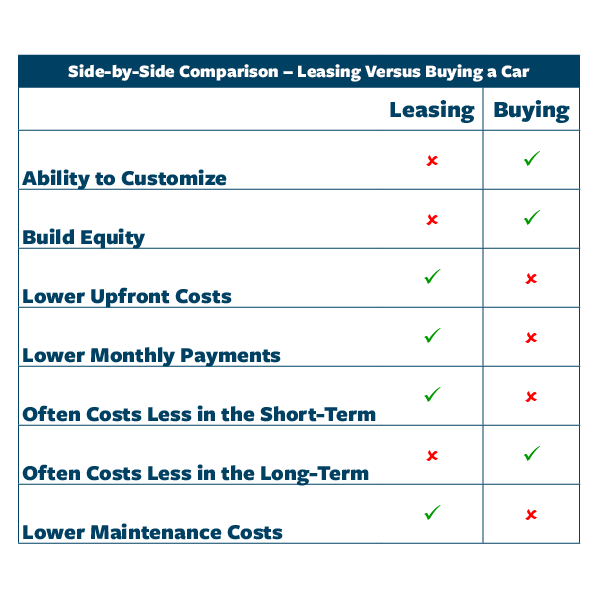It’s a highly personal decision, but some considerations can help you build a pro/con list so that you feel financially awesome about your choice.

Initial costs
The average transaction price for light vehicles in the U.S., as reported by Kelly Blue Book analysts, reached $35,285 in March 2018. If you’re thinking of buying a new car, that’s a big wad to hand over, so financing is likely in the picture. If a lender requires 10 percent down, that’s still several thousand dollars. Plus, your financing package will be based on the total negotiated purchase price. To pay lower interest rates or reduce monthly payments, you’ll need to bulk up your down payment.
With leasing, you’re not financing the entire negotiated purchase price of the vehicle. Instead, you’re financing the depreciation over the lease period. Most leases extend two to three years, after which the lease holder plans to sell the car for an expected value. If a $35,000 car should be worth $20,000 in three years, then you finance the $15,000 difference. If you have a good credit history, it may be possible to enter an agreement with zero or little money down.
Recurring costs
Consider how monthly payments will impact your overall budget. Lease agreements tend to have lower monthly payments than auto loans for comparable vehicles because the amount at stake is smaller. Be sure to incorporate costs of interest, insurance and gas when factoring your overall expenses relating to your new wheels. Some leasing agents may require additional insurance coverage, which can increase your monthly expenses.
For buyers, it may be helpful to funnel additional dollars into a maintenance fund, as most upkeep will be your responsibility. Some lease holders may include general maintenance in their agreements, and any necessary repairs would likely fall under warranty.
Lease restrictions
When you buy a car, the car is yours to customize and use as you like, from upgrading the paint job to taking back-to-back epic road trips to joining the ride-hailing force on the roads. When leasing, some of these options may not be available or may come at a price.
As lease holders are interested in preserving their car’s value, most agreements include an annual mileage limit, such as a cap of 12,000 miles a year or 36,000 during a three-year lease. Exceeding the limit could run anywhere from $0.10 to $0.25 per mile, which can add up quickly.
Be prepared to pay wear and tear fees on a leased vehicle upon return. Any customization must be removed without a trace to avoid fees. And if your parallel parking leaves something to be desired, know it could cost a little more than some embarrassing YouTube moments. In general, wear and tear fees can total up to three months of payments.
Finally, if you’re planning to cover monthly payments with a side hustle shuttling between clubs on weekends, know that some lease holders won’t allow using their vehicles for this purpose.
Equity benefits
Although vehicles depreciate in value over time, the type of vehicle and its condition will determine how much cash value remains once you’re ready to move on. If you leased a vehicle and reached the end of the agreement, you have no ownership stake and must start over.
A car that is paid off gives you options. You can continue driving it while pocketing that extra cash each month. You can trade it in, using your equity to reduce the financed amount on a new model. Similarly, you can sell it and use the proceeds for a down payment on a new ride.
Final thoughts
If having the latest technology and safety features is important to you, then leasing a car for the short-term may be a good fit. Every few years, you’ll be able to start anew if you’ve maintained good credit. Or, if you’re just looking for reliable transportation and want to reduce your monthly obligations down the road, buying a vehicle that you can drive for many years may make sense.
Whichever option you choose, do some research to understand the associated costs and learn which terms could be negotiable. After all, you’re the one in the driver’s seat.

